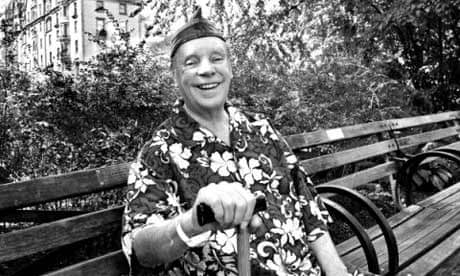Tom O'Horgan - once dubbed the Busby Berkeley of the acid set, who has died aged 84 - was the big daddy of the modern rock musical, having directed the world premieres on Broadway of Hair and Jesus Christ Superstar. His style of direction - eclectic, fizzy and extravagant - was organically evolved in the off-off-Broadway theatre of the mid-1960s and rooted in an alternative lifestyle and the hippy culture. He often began his rehearsals with spiritual communion and trust exercises.
Following a raft of sensational productions at Ellen Stewart's Cafe La MaMa in the East Village, New York, O'Horgan was named theatrical director of the year by Newsweek in 1968. In 1971 he was responsible for four shows running simultaneously on Broadway: Hair; Superstar; Lenny, a celebration of the scabrous comedian Lenny Bruce; and Inner City, a series of fairytale parodies highlighting outrages in the black ghetto.
This was his time, and he never really thrived beyond it, though he made a decent film of Eugène Ionesco's surreal masterpiece Rhinocéros with Zero Mostel and Gene Wilder in 1974 and, in the same year, staged an ambitious tribute show to the Beatles, Sgt Pepper's Lonely Hearts Club on the Road. He was diagnosed with Alzheimer's disease in 2002, and although he attended last year's Central Park revival of Hair, he said that he remembered nothing about it.
Hair, billed as the "American tribal love-rock musical", had sprouted in Joseph Papp's New York Shakespeare Festival Theatre (home, too, of the subsequent decade's longest running musical, A Chorus Line), opening at the Biltmore on Broadway in April 1968. The show, with an irresistible score by Galt MacDermot and book and lyrics by Gerome Ragni and James Rado, spread a new kind of liberating joy in the theatre, raising issues of sex, religion, colour, drugs and the draft.
An unknown cast, including Diane Keaton, hymned the Age of Aquarius, stripped off at the end of the first act and let the sunshine in at the end of the second. When the show opened in London at the Shaftesbury theatre with a cast including Paul Nicholas, Annabel Leventon and Marsha Hunt, even Princess Anne joined the cast onstage at the end for the dancing love-in finale. Theatre was changed for ever, and the revolution went mainstream.
O'Horgan attracted scorn from the critical avant garde, who felt he had sold out, and disdain from the purists for his wacky, outrageous style of synthesising many influences. Andrew Lloyd Webber, co-author with Tim Rice of Jesus Christ Superstar, disliked his 1971 staging intensely, although he conceded that the beginning was very clever: "The floor of the stage was vertical," he recalled, "and, as it went down, people swarmed over the top of it, like ants."
Having replaced the original Superstar director with a brief to "theatricalise" the oratorio, which had already played concert performances all over America, O'Horgan filled the stage with huge angels swinging on psychedelic wings across shimmering, surreal sets, laser beams, dancing dwarves and lepers, and a crucifixion scene set on a dazzling golden triangle. All this changed when the musical opened in London at the Palace in Jim Sharman's stark and gripping production the following year.
Most of O'Horgan's subsequent income came from royalties negotiated on Superstar, but he never stopped working, including workshops and readings in his large loft at 840 Broadway on 13th Street, which was crammed with musical instruments of every kind and became a party destination for guests including Leonard Bernstein, Norman Mailer, Beverly Sills and Gore Vidal.
Born in Chicago, where his father was proprietor of a small newspaper, O'Horgan grew up singing in churches and writing plays. He studied at DePaul University, Chicago, and learned to play many instruments before he moved to New York, where he began acting in Greenwich Village. By 1968 he had directed more than 50 plays, films and "happenings" with La MaMa Experimental Theatre Club.
He directed a film of Rochelle Owens' bizarre Futz! (1969), starring Frederic Forrest as a farmer who forsakes women for his pet pig. Another La MaMa hit, Paul Foster's Tom Paine, was presented in London at the Vaudeville theatre by the producer Michael White in 1967. But O'Horgan's Broadway reputation took a severe knock when Dude (1972), a sort of environmental Everyman sequel to Hair by MacDermot and Ragni, flopped badly, although he maintained the score was better than either Stephen Sondheim's Follies or Jerry Herman's Hello, Dolly!
In November 2007, he put up for sale the entire contents of his apartment - the huge collection included horns, harps, dulcimers, bagpipes, serpents, wind chimes, didgeridoos, gongs and xylophones - and moved to live in a condominium near the beach in Sarasota, Florida. This was partly to pay for the round-the-clock care he needed (though some of the proceeds went to the New York chapter of the Alzheimer's Association), but also to keep warm and be looked after by his long-term friend and one-time lover Marc Cohen and Cohen's wife, Julia. He went through bouts of feeling unloved in New York, telling an interviewer in 1993 that he had been put on "an enemies list" by critics and other members of the theatrical establishment.
